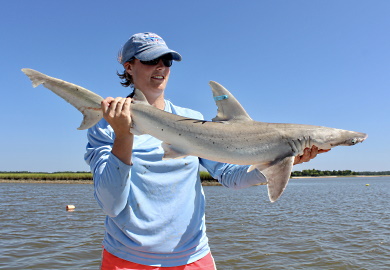October 3, 2019

SCDNR biologist Ashley Galloway holds a bonnethead shark caught and tagged in Bull's Bay. (Photo: E. Weeks/SCDNR)
If you fish on the South Carolina coast, chances are you’re no stranger to the bonnethead shark.
These small, unusual members of the hammerhead family are one of the most common shark species caught both on rod and reel and in trawl nets – but despite their familiarity to anglers, little is known about how bonnetheads fare after catch-and-release encounters.
A recently awarded federal grant will allow South Carolina Department of Natural Resources (SCDNR) and Georgia Southern University (GSU) biologists to zero in on how well bonnetheads survive fishing interactions.
On Wednesday, October 2, NOAA Fisheries’ national Sea Grant program announced the recipients of its competitive Highly Migratory Species Research Initiative, the goal of which is to fill gaps in the scientific understanding of tunas, billfish and sharks. SCDNR and GSU were awarded $278,000 for a project that will determine the survival rate of bonnetheads after being caught and released by recreational anglers and commercial shrimp trawlers.
“This research is important because the vast majority of bonnetheads captured in these two fisheries are released,” said SCDNR biologist Bryan Frazier, who will be leading the project. “We know through studies of other shark species that despite anglers’ best intentions, some of these fish die due to the stress of capture.”
Bonnetheads grow no larger than four feet in length and have characteristic shovel-shaped heads that make them easy to identify. They’re a common sight in shallow saltwater environments, where they’re often seen cruising the shoreline in search of crabs, shrimp, and small fish. Interestingly, bonnetheads are the only shark on the planet known to also eat plants – recent research has shown that seagrass may make up as much as 60% of the diets of bonnetheads in Florida, however in South Carolina they primarily feed on blue crabs and shrimp.
Working collaboratively with charter boat captains, shrimp trawlers and researchers from GSU and Florida State University, biologists will use a variety of techniques to gather information about what happens both when a bonnethead is caught and after it is released.
By outfitting 140 bonnethead sharks with satellite and acoustic tags across both fisheries, the research team will be able to monitor the status of post-release sharks.
“We can look at acoustic transmitter data to determine whether sharks survive – if a tag stops moving within the receiver network, we can infer the shark died. Similarly, satellite tags can also give us information on survival of bonnetheads captured outside of our acoustic receiver networks.” Frazier said.
Additionally, by analyzing blood samples, biologists hope to learn more about the stress responses of bonnethead sharks when they’re caught.
Combing all of this data will allow researchers to determine what proportion of bonnetheads are not surviving their catch-and-release encounters – providing fisheries managers with the information needed to ensure bonnetheads continue to thrive in South Carolina. The project is expected to start in April 2020 and will last 2 years.



